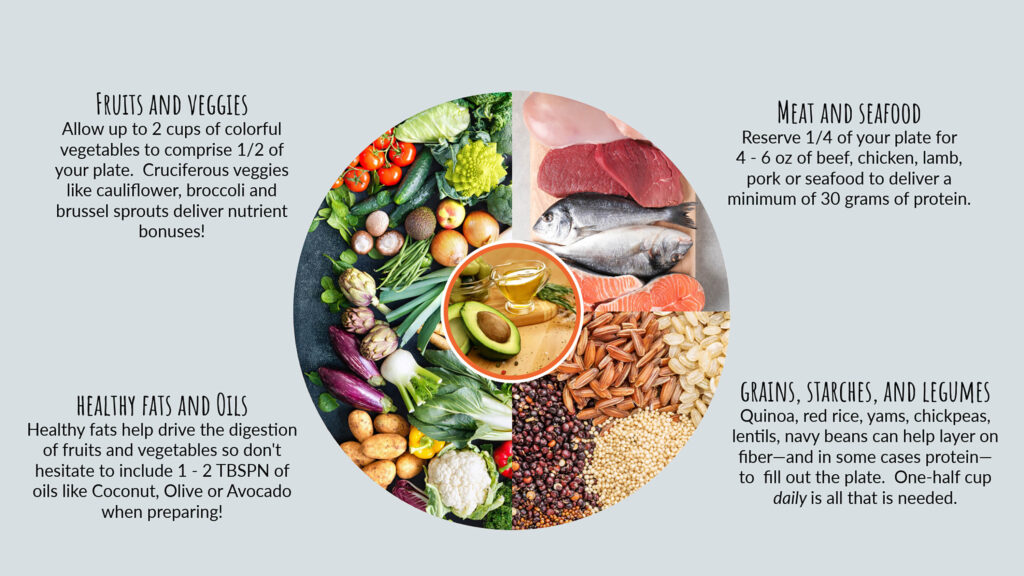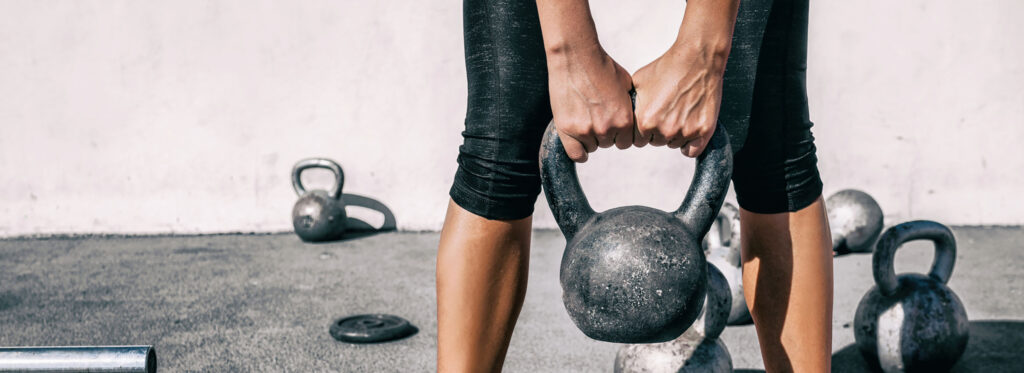I am happy to report that while menopause is an inevitable fact of being born female, the suffering associated with it, is not.
PSSST is the acronym I have used to highlight the five areas where making small positive changes nets you the biggest results when it comes to both long-term health and mitigating the impacts of hormonal change. It breaks down like this:
P = Protein + Plant Loving Meals
S = Strength Training
S = Successful Sleep
S = Stress Management
T = Talking Your Experience
P= Protein + Plant-Loving Meals
When it comes to losing unwanted belly fat and regaining your energy, refocusing your nutrition to take in adequate amounts of high quality protein and healthy servings of fiber-rich fruits and vegetables is a game changer that can lead you to leave diets permanently in the past.
If you were to design your plate… it would look a little something like this:

Protein for women, in particular, goes largely under-represented on the daily menu. As an essential macronutrient, protein is actually a delivery mechanism for 20 amino acids that help the body build, restore, and repair—even beyond skeletal muscle, which we critically need to support at this stage. If you are a woman on the go, medical experts, such as Gabrielle Lyon, MD, recommend a guideline of 1 gram of protein per pound of ideal body weight (Ideal = weight at which you feel your healthiest), and largely consumed through whole foods (vs. bars and supplements). I know what you are thinking: how can you possibly consume that much protein? The place to start is a little return to the basics: ensuring it’s part of the three basic meals of the day—breakfast, lunch, and dinner— and then aiming to include 30 – 40 grams in each meal. Snacks—one to two representing 15 – 20 grams of protein each—can be added where needed, based on your overall protein needs.
“Plant-loving” is the phrase I lean into over “plant-based” as that second phrase often gets confused with the idea of adopting a strictly vegetarian diet (vegetarian = plant-based; plant-based ≠ vegetarian). When we demonstrate a love of plants at each meal, we get to leverage the multiple nutrients these colorful complements offer; more importantly though, fiber-rich fruits and vegetables help support a healthy gut, allow us to feel “full,” and more slowly release sugar into the blood, allowing us to avoid sugar highs and lows that drive those afternoon energy craters that are soon quickly followed by sugar or snack cravings.

S = Strength Training
No one says it better than Next Level author Dr. Stacy Sims—at this stage of life, we need to “lift heavy sh*t.” Why? Two reasons: muscle loss and bone density loss. In fact, we can lose up to 10% of our appendicular muscle mass during the perimenopausal years alone and up to 20% of our bone mass in certain areas. And then there are the wider impacts.
As the largest endocrine organ in the body, muscle is responsible for body movement, posture, temperature, glucose regulation, soft tissue support AND metabolism. When muscle loss increases, we not only impact our ability to move as we age, but we greatly affect our metabolism, leading to greater fat accumulation, insulin resistance, and an increasing risk for chronic and metabolic diseases, like type-2 diabetes. Less protective muscle and more brittle bones also make us more likely to experience fractures and breaks.
So how do we combat the loss? The one-two punch of protein plus strength training; more specifically, lifting heavy-to-you weight (think: 5 reps max where the 4th and 5th rep are considerably harder than the first two). In combination with adequate protein consumption, strength training not only mitigates muscle loss, but it stimulates the mind and body to build a new, fortifying bone and body to handle new loads. If that wasn’t enough, here’s some additional benefit: more muscle drives increased metabolism—so don’t just feel the burn, say goodbye to unwanted visceral fat, and with that, you may even reduce your incidence of hot flashes and night sweats!
If strength training—or exercise, in general—is not part of your current practice, the most important take away here is to begin to move and do whatever movement it is that you love to do or drives your curiosity. Walking, dancing, jumping rope, playing tennis, trying pickleball—you get the idea—are all great places to start and will deliver benefits. If you are ready to take a leap and strength train, find a qualified professional (fitness coach or personal trainer) who can assess how your body moves and teach you proper form before adding any weight—form and movement are key to avoiding injury and building momentum.

S = Successful Sleep
Sleep, for many perimenopausal women, is the stuff dreams are made of—especially at 3 am when the mind is suddenly awake and running through a cycle of thoughts, ideas, grievances, and to-dos.
Many of us think about a good night’s sleep as being well rested for the next day, but sleep is so much more than that. It is during sleep that the body actively engages in repairing, restoring, and rebuilding itself (fun fact: that “behind-the-scenes work” utilizes the same amount of energy, i.e., calories, as an average workout!). A good night’s sleep will improve your mental sharpness AND increase your strength—take that brain fog and muscle loss!
Most experts recommend a minimum of 7 hours, but for many, myself included, that can sometimes feel like climbing Everest. So how can you improve your quality and quantity of sleep? For those just trying to get to sleep, establishing a “wind down” routine can be a great place to start. During the “wind down”—that hour or two before you turn the lights out—the goal is to prepare yourself for sleep by focusing on relaxation and de-emphasizing, or outright avoiding, activities that rev up the mind and body (think: eating, drinking, and “screen-timing”). Think: settling in with a good book, going for an evening walk, or maybe enjoying some pampering at-home skin care.
If your problem looms large at what I like to call “3 am Eternal,” many experts recommend employing strategies that help disrupt the thought cycling, such as getting up and reading a book in another room (note: avoid the temptation to read on your device as blue light is stimulating and disrupts melatonin production!). However, if you are like me and don’t want to leave the comfort of your bed, there are options to consider such as breathing techniques, and cognitive behavioral therapies, which recent studies have shown to be extremely effective. A recent personal favorite for me: mentally “repeating” positive mantras, as it allows me to turn away from anxiety inducing thoughts and re-asserts some mental control.
Another major disruptor of sleep, of course, is vasomotor symptoms—the hot flashes aka night sweats that result due to the brain’s “misreading” of core body temperature (one suspected root cause: fluctuating and decreasing estrogen). While keeping your sleeping environment cool and purchasing sweat-wicking pajamas are two solutions within arm’s reach, re-focusing exercise and nutrition can also dial down, and possibly eliminate, these symptoms over time. Where vasomotor symptoms severely impact sleep and therefore, quality of life, hormone therapy and non-hormonal prescription medications, have also proven effective for providing relief.

S= Stress Management
One of the most surprising symptoms for women during the menopause transition is the ever-present undercurrent of stress—you might recognize it as that feeling where you are ready to TAKE. ON. ANYONE. Given estrogen’s role in regulating and influencing our stress hormones, it’s no wonder that its dramatic fluctuations during this time would leave us experiencing the effects of higher cortisol levels (and incredibly on edge). A discussion around adaptogens or prescribed solutions with your health care provider is certainly worth having if you feel stress is interfering with your ability to relate to others and conduct the activities of your day-to day-life. Other strategies such as employing breathing techniques, guided meditation, exercise, or outside physical activity breaks (i.e., walking) can also effectively take your stress level down. That said, if the mere thought of developing your own stress management strategy only leads to more overwhelm, then employing a life coach may help. As certified professionals, life coaches can work with you to develop a rich toolbox of pre-emptive and coping strategies that integrate seamlessly into your life and various situations.

T = Talking Your Experience
As a culture, we have begun breaking down the barriers of talking about the menopause transition—but like many an early adopter you may find yourself out ahead of some of your friends, family members, and even, sadly, your providers. Don’t let that stop you from talking about it! Making this THE conversation topic is key to advancing it, taking us to a place where more women will understand what is happening to their bodies, AND feel confident that they have at-hand tools to do something about it.
It will also drive many institutions to catch up—from government funding of women’s health research to medical schools prioritizing menopause and women’s health in their curricula. As a woman experiencing the signs or symptoms, it is imperative that you can speak comfortably to a medical professional who is knowledgeable and empathetic to your needs. Ending a proposed conversation with “it’s normal” is no longer acceptable.
If you find yourself in need of a new provider—whether it be an OBGYN or a family medicine physician, The Menopause Society (formerly The North American Menopause Society) is a place to start. There you can search among their registry of certified physicians for a provider near you. Your friends also may offer a rich resource of providers they have worked with and who have supplied them with needed information and/or available treatments and solutions, such as hormone therapy.
The net net: find your “partner for life”— a physician who allows you to be heard, helps you pursue the care you need, and sets the stage for healthy, vibrant living for years to come.
Small Steps Leads to Big Changes
Like all practices that may be new, it’s important to start with small manageable steps. Adopting too much change all at once can feel overwhelming, leading you to stop before you even get started. So as you contemplate this strategy consider starting small—maybe even with a focus in one area—to garner early and long-term “success.” If the idea of “going it alone,” keeps you from going at all—then consider employing a coach (like me) who can champion your goals, support healthy habit development, and provide a measure of accountability. Remember, the best ROI is the ROY (return on you)!
What is one small step you plan to take to transform your menopause experience?

View comments
+ Leave a comment